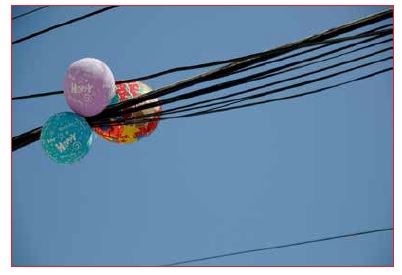Celebrations Go Virtual but Metallic Balloon Hazards Remain All Too Real
By Paul Netter

From in-person to virtual, celebrations from Mother’s Day to proms to birthdays have continued during the COVID-19 pandemic.
Unfortunately, despite the virtual celebrations, so have the power outages and electrical safety hazards caused by adrift metallic balloons, though fewer in number but still troubling.
Graduations, however, are upon us and the May and June festivities always drive a peak in the release of the helium-filled balloons that can drift for miles and weeks before destructively ending up in power lines and electrical equipment.
Southern California Edison — which experiences on average nearly three balloon-caused outages daily, including 1,022 last year — has seen that number rise to nearly four outages a day in May (686) and nearly five a day in June (836) over the last five years, including 128 and 152, respectively, in those months last year. This is compared to about one per day (28) in the lowest month of December.
All of which leads to — despite California’s COVID-19 restrictions helping decrease April’s balloon outages substantially from 115 last year to 50 this year — stern warnings about their release during National Electrical Safety Month.
“Even one released metallic balloon endangering public safety and potentially causing a power outage is one too many,” said Andrew Martinez, vice president of Safety, Security and Business Resiliency at SCE. “Nobody should ever release balloons outdoors and they should always be kept tied to a weight as state law requires to prevent them from even unintentionally floating away.”
Unintentional or otherwise, an even greater threat to public safety occurs when metallic balloons make contact with electrical equipment and bring down power lines — as they did 98 times last year — potentially leading to wildfires, serious injuries and property damage.
For instance, on a recent afternoon in Lancaster, metallic balloons landed in overhead equipment, knocking out power for more than 2,000 customers. While the outage was momentary and brief for most of the customers, it lasted for nearly six hours for the final 346 customers because of the required repairs to equipment damaged by the balloon contact.
Scott Brown, an SCE Fire Management officer who spent 14 years as a first-responder troubleman for the utility, says the serious hazards presented by balloons tangled in power lines can’t be overstated.
“We do our best to minimize these outages, but the hazards involved in clearing balloons from a 16,000-volt overhead power line are far too great for us to get close to,” said Brown, who removed many balloons from power lines as a troubleman. “So, it’s very important that we keep a good handle on metallic balloons, keep them tethered and keep them indoors if possible.”
SCE reminds customers to stay away and call 911 if they ever see downed lines, continues its safety ad campaign to educate customers about the hazards of released metallic balloons and supports the state’s secure-is-safe laws against their release.
“These are very preventable outages,” said Martinez. “With safety as the ultimate concern, all we want is our customers to understand the risks and be responsible with metallic balloons.”
Metallic Balloon Safety Tips
• Metallic balloons should never be released outdoors.
• Metallic balloons should always be tied to a weight.
• Stores and vendors should only sell properly weighted balloons.
• Keep the balloons indoors when possible.
• Never try to retrieve balloons tangled in power lines or electrical equipment. Call 911 instead.
• Cut the knot or puncture balloons before disposing of them.
-----------------------------------------------------------------------------

